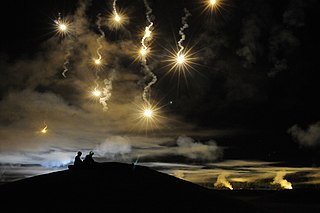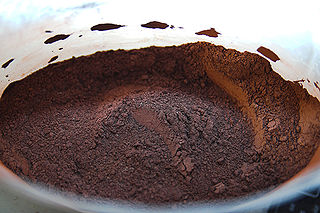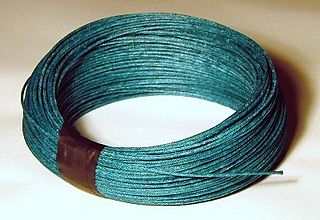
A flare, also sometimes called a fusee, is a type of pyrotechnic that produces a brilliant light or intense heat without an explosion. Flares are used for distress signalling, illumination, or defensive countermeasures in civilian and military applications. Flares may be ground pyrotechnics, projectile pyrotechnics, or parachute-suspended to provide maximum illumination time over a large area. Projectile pyrotechnics may be dropped from aircraft, fired from rocket or artillery, or deployed by flare guns or handheld percussive tubes.

Thermite is a pyrotechnic composition of metal powder, which serves as fuel, and metal oxide. When ignited by heat, thermite undergoes an exothermic reduction-oxidation (redox) reaction. Most varieties are not explosive, but can create brief bursts of heat and high temperature in a small area. Its form of action is similar to that of other fuel-oxidizer mixtures, such as black powder.

Pyrotechnics is the science and craft of using self-contained and self-sustained exothermic chemical reactions to make heat, light, gas, smoke and/or sound. The name comes from the Greek words pyr ("fire") and tekhnikos. Pyrotechnics includes, among other things, fireworks; safety matches; oxygen candles; explosive bolts and other fasteners; parts of automotive airbags; and gas-pressure blasting in mining, quarrying, and demolition.

A skyrocket is a type of firework that uses a solid-fuel rocket to rise quickly into the sky; a bottle rocket is a small skyrocket. At the apex of its ascent, it is usual for a variety of effects to be emitted. Sky rockets use various stabilisation techniques to ensure the flight follows a predictable course, often a long stick attached to the side of the motor, but also including spin-stabilisation or fins.

A firecracker is a small explosive device primarily designed to produce a large amount of noise, especially in the form of a loud bang; any visual effect is incidental to this goal. They have fuses, and are wrapped in a heavy paper casing to contain the explosive compound. Firecrackers, along with fireworks, originated in China.

A sparkler is a type of hand-held firework that burns slowly while emitting colored flames, sparks, and other effects.

In an explosive, pyrotechnic device, or military munition, a fuse is the part of the device that initiates function. In common usage, the word fuse is used indiscriminately. However, when being specific, the term fuse describes a simple pyrotechnic initiating device, like the cord on a firecracker whereas the term fuze is sometimes used when referring to a more sophisticated ignition device incorporating mechanical and/or electronic components, such as a proximity fuze for an M107 artillery shell, magnetic or acoustic fuze on a sea mine, spring-loaded grenade fuze, pencil detonator, or anti-handling device.
In fireworks, a burst charge is a pyrotechnic mixture placed in a shell which is ignited when the shell reaches the desired height in order to create an explosion and spread the stars. Burst charge compositions are usually coated onto rice hulls or other low-density fillers, which increases the rate of combustion.

Flash powder is a pyrotechnic composition, a mixture of oxidizer and metallic fuel, which burns quickly and if confined produces a loud report. It is widely used in theatrical pyrotechnics and fireworks and was once used for flashes in photography.

A visco fuse is a higher-quality fuse used for consumer fireworks. It is most commonly colored green or red, and is found as a twisted, coated strand. It is also used to create delays in the firing of multiple firework displays.

Fireworks in the UK are governed primarily by the Fireworks Regulations 2004, the Pyrotechnic Articles (Safety) Regulations 2015, and British Standards BS 7114 until 4/7/17 and BS-EN 15947-2015.
Powder coating is a type of coating that is applied as a free-flowing, dry powder. Unlike conventional liquid paint which is delivered via an evaporating solvent, powder coating is typically applied electrostatically and then cured under heat. The powder may be a thermoplastic or a thermoset polymer. It is usually used to create a hard finish that is tougher than conventional paint. Powder coating is mainly used for coating of metals, such as household appliances, aluminium extrusions, drum hardware and automobile and bicycle parts. Newer technologies allow other materials, such as MDF, to be powder coated using different methods. The powder coating process was invented around 1945 by Daniel Gustin US Patent 2538562.

Thermal spraying techniques are coating processes in which melted materials are sprayed onto a surface. The "feedstock" is heated by electrical or chemical means.

A flare or decoy flare is an aerial infrared countermeasure used by a plane or helicopter to counter an infrared homing ("heat-seeking") surface-to-air missile or air-to-air missile. Flares are commonly composed of a pyrotechnic composition based on magnesium or another hot-burning metal, with burning temperature equal to or hotter than engine exhaust. The aim is to make the infrared-guided missile seek out the heat signature from the flare rather than the aircraft's engines.
Thermalite a specific type of fuse used in pyrotechnic applications. The product was designed to be used in cross matching safety fuses of the Bickford type. As safety fuse is designed to neither give nor take fire through the heavy fuse jacket, ignition may be achieved by punching a hole perpendicular to and through a safety fuse powder core, threading a piece of Thermalite or similar igniter cord through the hole, then gently squeezing the safety fuse with pliers or similar to bring the powder core into contact with the igniter cord. The Thermalite could be ignited by a match, or more certainly by a purpose made igniter, similar to a wire sparkler.
In firearms and artillery, the primer is the chemical and/or device responsible for initiating the propellant combustion that will push the projectiles out of the gun barrel.

Fireworks policy in the United States can be different in each jurisdiction.















